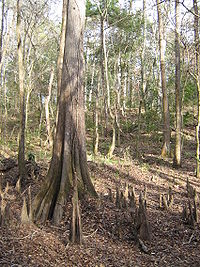
Cypress knee
Encyclopedia

Cupressaceae
The Cupressaceae or cypress family is a conifer family with worldwide distribution. The family includes 27 to 30 genera , which include the junipers and redwoods, with about 130-140 species in total. They are monoecious, subdioecious or dioecious trees and shrubs from 1-116 m tall...
tree
Tree
A tree is a perennial woody plant. It is most often defined as a woody plant that has many secondary branches supported clear of the ground on a single main stem or trunk with clear apical dominance. A minimum height specification at maturity is cited by some authors, varying from 3 m to...
of any of various species of the subfamily Taxodioideae. Their function is unknown, but they are generally seen in swamp
Swamp
A swamp is a wetland with some flooding of large areas of land by shallow bodies of water. A swamp generally has a large number of hammocks, or dry-land protrusions, covered by aquatic vegetation, or vegetation that tolerates periodical inundation. The two main types of swamp are "true" or swamp...
s. Some scientists have thought they may help in providing oxygen to the tree and assist in anchoring the tree in the soft, muddy soil.
Knees are wood
Wood
Wood is a hard, fibrous tissue found in many trees. It has been used for hundreds of thousands of years for both fuel and as a construction material. It is an organic material, a natural composite of cellulose fibers embedded in a matrix of lignin which resists compression...
y projections sent above the normal water level, roughly horizontally from the root
Root
In vascular plants, the root is the organ of a plant that typically lies below the surface of the soil. This is not always the case, however, since a root can also be aerial or aerating . Furthermore, a stem normally occurring below ground is not exceptional either...
s, with a near-right-angle bend taking them roughly vertically downward into soil, usually passing through water first. One early assumption of their function was that they provided oxygen to the roots that grow in the low dissolved oxygen
Oxygen
Oxygen is the element with atomic number 8 and represented by the symbol O. Its name derives from the Greek roots ὀξύς and -γενής , because at the time of naming, it was mistakenly thought that all acids required oxygen in their composition...
(DO) waters typical of a swamp (see also mangrove
Mangrove
Mangroves are various kinds of trees up to medium height and shrubs that grow in saline coastal sediment habitats in the tropics and subtropics – mainly between latitudes N and S...
s, which have similar adaptations), acting as pneumatophores. However, there is little actual evidence for this; in fact, swamp-dwelling specimens whose knees are removed continue to thrive, and laboratory tests demonstrate that they are not effective at depleting oxygen in a sealed chamber. Despite the fact that there is no expert consensus on their role, the supposition that they are pneumatophores is repeated without note in several introductory botany textbooks.
Another more likely function is that of structural support and stabilization. Lowland or swamp-grown cypresses found in flooded or flood-prone areas tend to be buttressed and "kneed," as opposed to cypresses grown on higher ground which may grow with very little taper.
Trees that develop these "knees" include the following:
- GlyptostrobusGlyptostrobusGlyptostrobus, is a small genus of conifers in the family Cupressaceae. The sole living species, Glyptostrobus pensilis, is native to subtropical southeastern China, from Fujian west to southeast Yunnan, and also very locally in northern Vietnam and Borikhamxai Province of eastern Lao PDR near the...
- Bald CypressTaxodium distichumTaxodium distichum is a species of conifer native to the southeastern United States.-Characteristics:...
- Pond CypressTaxodium ascendensTaxodium ascendens, also known as Pond Cypress, is a deciduous conifer of the genus Taxodium, native to North America. Many botanists treat it as a variety of Bald Cypress, Taxodium distichum Taxodium ascendens, also known as Pond Cypress, is a deciduous conifer of the genus Taxodium, native to...
- AhuehueteTaxodium mucronatumTaxodium mucronatum, also known as Montezuma Cypress, Sabino, or Ahuehuete is a species of Taxodium native to much of Mexico , and also the Rio Grande Valley in southernmost Texas, USA as well as Huehuetenango Department in Guatemala...
External links
- Christopher H. Briand. "Cypress Knees: An Enduring Enigma." Arnoldia. 2000-2001.Vol. 60(4). p. 19-20, 21-25. An extensive review of the published literature concerning cypress knees.

